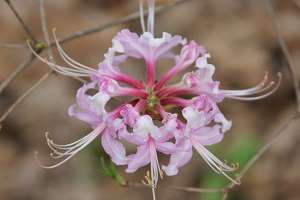By Frank M. Watson

Fall has arrived! As the summer heat begins to subside, fall becomes an ideal time to plant woody ornamentals.
Following proper planting procedures is essential. Often when I go out into the community to help homeowners diagnose shrub problems, it turns out the problem is the result of poor planting. The most common plants with this problem are popular plants, such as azaleas and junipers.
First, the planting hole should be dug twice as wide as the root ball and one-and-a-half times as deep. Although the hole should be deeper than the root ball, the plant should not be set too deeply in the soil. Be sure to backfill soil under the root ball so that the top of the root ball is slightly above or level with the soil.
Organic soil amendments, such as peat moss, topsoil and pine bark mulch, may be useful to improve excessively sandy or clay soils. However, soil amendments should be evenly incorporated into the planting area and not added directly to the planting hole. Poor root growth and/or root rot can often result from soil amendments being added directly to the planting hole. Water is held against the roots by uneven or irregular layers of soil texture.
Often when planting azaleas and other woody ornamentals, particularly in sites where there have been failures in the past, it is helpful to rinse the potting medium from the roots before planting. Many Georgia soils high in clay will wick moisture away from pine bark-based growing mixes. This makes it difficult for the plant to obtain the water it needs.
Another common mistake that home landscapers make is failing to break up the root ball prior to setting the plant into the hole. This practice helps the root ball expand into the surrounding soil. Failure to break up the root ball usually causes the plant to continue to be root-bound. Most plants are root-bound to some degree when they are purchased in containers. If the root ball is not broken up, the roots can grow inward, upward or around the root ball without penetrating the surrounding soil.
Digging a hole just big enough for the root ball has a similar effect. Both mistakes result in a stressed plant that is more susceptible to disease and may inexplicably die during harsh environmental conditions. In plant clinics, University of Georgia Cooperative Extension agents, like myself, are often asked to diagnose whole plants from the landscape with the root system still in the original shape of the pot.
To increase the success of newly installed plants, create a slightly elevated ring of soil around the plant. This will help water penetrate to the roots and discourage runoff. Finally, a good mulch layer of bark, straw or other material around the base of the plant will keep the roots moist and prevent the growth of weeds.
New plant material should be watered immediately after planting to settle the soil around the roots. Then, in the absence of rain, regularly irrigate for the next six to eight weeks so that the new plants may become established.
The best disease control is to begin with a healthy plant and to follow proper planting techniques to get plants off to a good start.
Source: uga.edu